Naturalist Notes: February in the Mountains
“No winter lasts forever, no spring skips its turn.” – Hal Borland
February is the beginning of my favorite stretch of year – the transition from winter into spring, and then spring into summer.
This winter I am finding myself drawn to the lowland forests and deciduous banks of the Skagit River. My time upriver has been the most wintery winter I’ve endured; I am now accustomed to the semi-regular process of scraping ice and snow off my windshield, and wearing microspikes as I walk down the icy road of the North Cascades Environmental Learning Center. However, a walk in the forest feels like a visit with an old friend. It reminds me of my island home at the other side of the watershed, Deception Pass. Everywhere in the forest, signs of familiar companions are appearing and talking and that makes my heart feel much warmer, though my toes and hands are just as cold.
These interactions have also filled my journal with many, flowery ramblings. In between classes, and now Mountain School trainings, I try to take a walk outside and note changes in my environment. February is especially a time of rapid change – one day it can be cool and damp out, and the next day there’s seven inches of snow on the ground and slush in my boots. Below, I’ve noted some of the changes witnessed within my little sphere of the world this past week. What have you noted, too?
Recent Naturalist Notes
On February 16 – I heard a Varied thrush (Ixoreus naevius) sing outside of my partner’s cabin in Marblemount, while branches cracked from the weight of freshly fallen snow.
February 17 – During a rainy walk in Rockport State Park, I found Indian plum (Oemleria cerasiformis), or osoberry, breaking leaf buds all along the Suak-Springs trail.
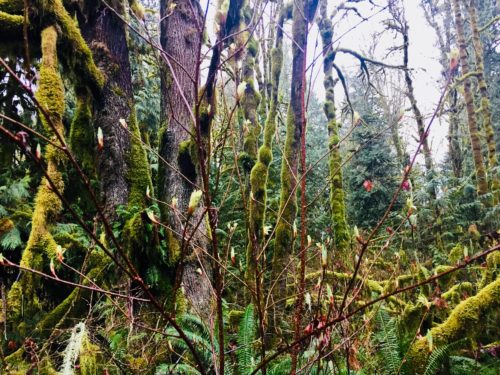
Also spotted were young buds on the Vine maple (Acer circinatum), leafy buds of the Salmonberry (Rubus spectabilis), and two of my favorite edibles popping up along the forest floor: Stinging nettle (Urtica dioica) and Siberian miner’s lettuce (Claytona sibirica). It’s only a matter of time until I can make a batch of nettle pesto!
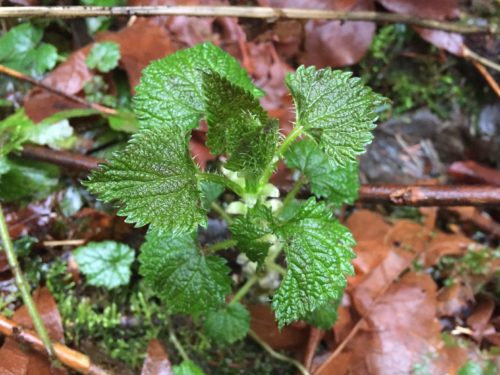
And there were signs of moss reproduction everywhere, with the stalk-like shoots of the sporophyte popping up. The spore capsules are about ready to release spores that will grow into new moss. Next time, I will take my hand lens with me to get an even closer look.
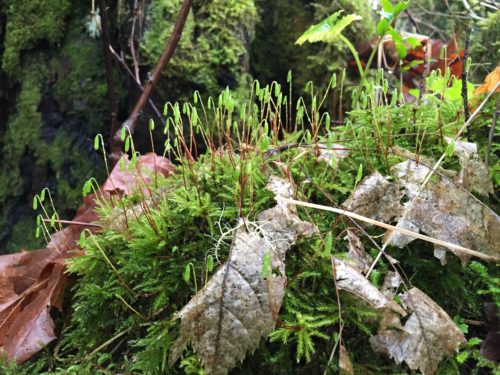
On the drive home, I stopped at mileposts 100 and 101 to stand by the Skagit River. I saw three Bald eagles (Haliaeetus leucocephalus) at 101 and noticed the snow line on the mountains and grey clouds. It felt good to stand close to the talking river and listen to the eagles.
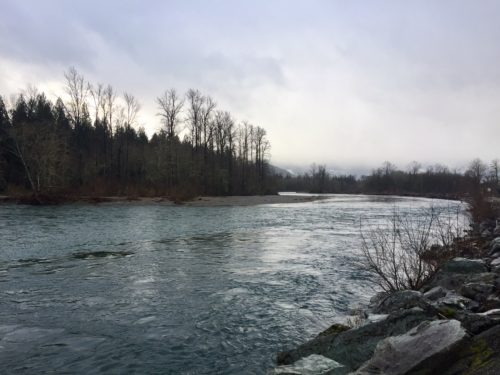
The Skagit River’s mood during the evening
February 18: Today I appreciated the sunshine and fresh snow on the trails during my run at Rockport State Park. There was a light dusting overnight, and the snow line crept to lower elevations on Sauk Mountain. Water rushed in the creeks from sunny snowmelt.
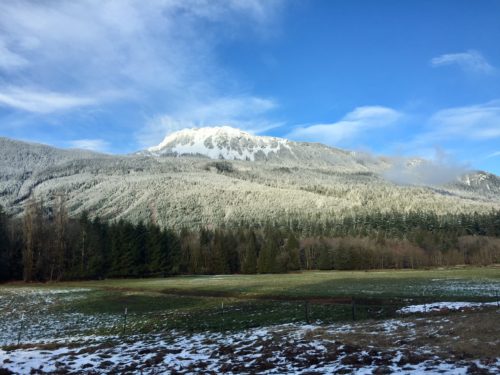
Sauk Mountain illuminated in the sun
The Evergreen Trail at Rockport State Park
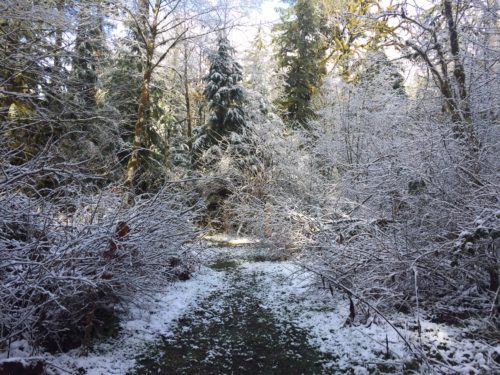
February 19: For my last day of break, I went skiing at Mount Baker. It was a bluebird day with no clouds in the sky and fresh snow. I heard from many folks that yesterday was an incredible powder day on the mountain, and that parking at the ski area was a mess from all of the people there to enjoy it!
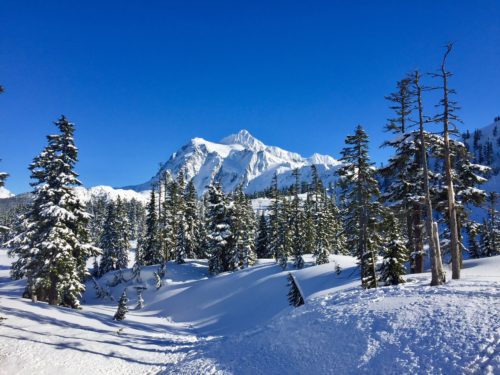
Mt Shuksan in a blanket of snow
February 20: On my return back to the Learning Center, I saw ice on Diablo Lake for the first time (I think?).
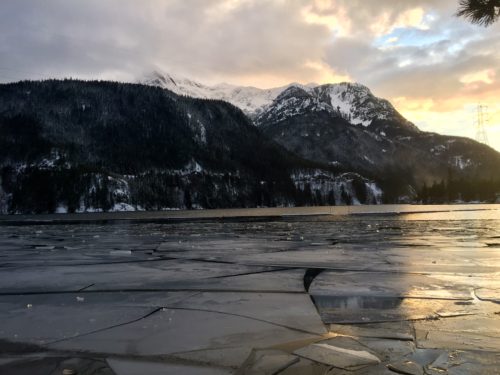
The shores of Diablo Lake covered in ice
There was also a break in cloud coverage that evening. During the sunset at 5pm, I saw a pocket of clear sky over the town of Diablo during a walk to the dam.
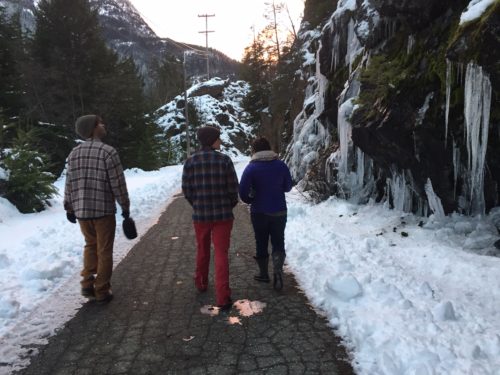
Amos Almy, Charlee Corra, and Amy Sanchez on the way to an overlook of Diablo
Large icicles hung off rocks, tree branches, and roof tops. And trees and rocks beneath the dam were covered in ice from the Seattle City Light spilling water. Some trees looked like jagged, crystalized ice sculptures.
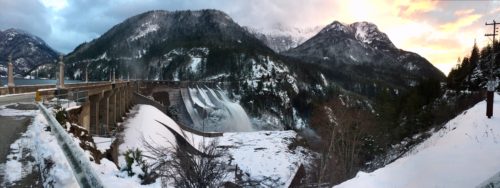
Seattle City Light releasing water from Diablo Dam
February 21: It was a grey and cold day spent mostly inside learning. However, I did sled down the slippery road to Mountain School training, as a fun way to celebrate my day of birth.
When outside, my graduate cohort and I saw a Red-breasted sapsucker (Sphyrapicus ruber) outside of the dining hall. During our mock Mountain School instructor orientation, Steller’s jays (Cyanocitta stelleri) also appeared and began to bark at us from nearby branches. I interpreted it as their anticipation for the spring Mountain School season ahead – the birds are ready to snag lunch scraps from wiggly fifth graders.
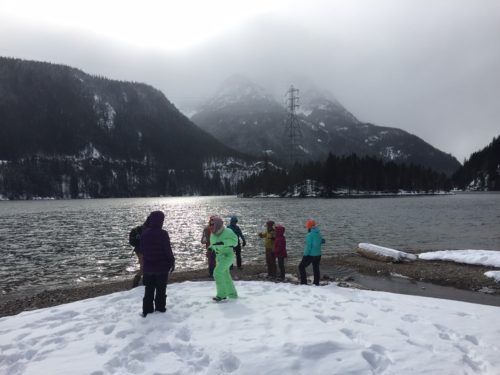
Graduate students participate in a Ranger program beside the lake
February 22: We played a game called Camouflage during our training. Graduate students and other instructors scattered into the forest around Deer Creek, in a game of naturalist hide and seek. I hid against the mossy trunk of a bare-leafed, Big-leaf maple (Acer macrophyllum), with the toe of my boots buried in the snow.
That night, around 7:30pm, the sky was absolutely clear during our night hike simulation. I could see the stars and the waxing crescent of the moon – an uncommon experience during winter in the North Cascades.
February 23: REALLY COLD DAY. My cohort and I had to go inside sooner than planned during training. Two pairs of socks, a wool base layer, thick pants, and a couple of jackets could hardly keep me warm. Again, we saw a sapsucker just outside the Lily Shelter. I wonder if it is the same one as before?
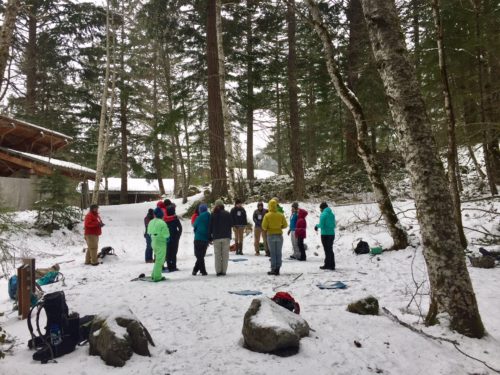
Graduate students learn Mountain School activities from Evan Holmstrom
This weekend the snow continues to fall, with a winter storm warning and a high avalanche alert in effect. There’s been so much snow I haven’t even attempted to drive down Highway 20. I wonder how this stretch of below-freezing weather will impact the budding plants… That’s something I will keep tabs on during my slow, reflective hikes around the area.
February 25 update:
SR 20 / North Cascades Highway closed at milepost 123 due to an avalanche. It happened just east of the town of Newhalem. Washington DOT will assess the slide tomorrow.


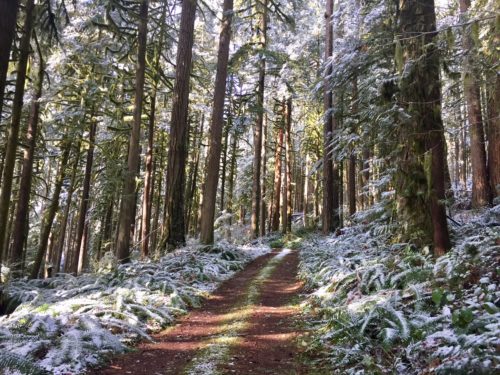
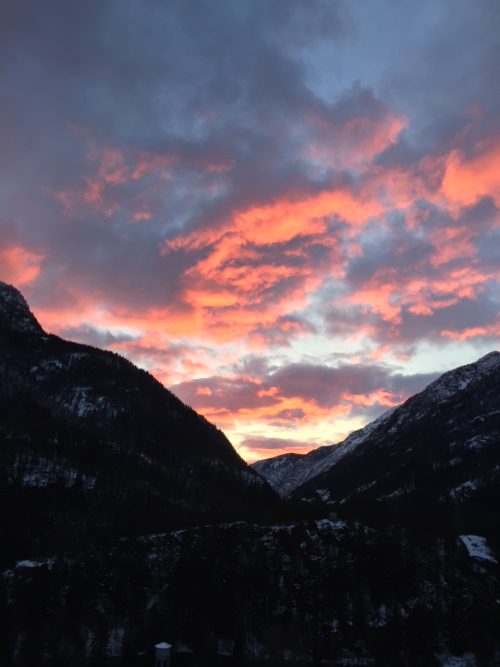
Enjoyed reading your daily observations Montana. What a beautiful place to experience seasonal change. Enjoy the 5th graders!
Kim, I heard your reading at the Village book store last night. My daughter Kortney and her daughter Mabel were there too. It was lovely. Do you remember having a workshop years ago at Mar Vista Middle School? Kortney and I arranged it and loved your presentation. You went to Tijuana that night and wrote a poem featuring a killdeer. We loved it but lost track of it. If you have it and if you remember us, please let me know. You are a rockstar poet to us. With love and admiration, Barbara, Kortney, and Mabel